Physical Address
304 North Cardinal St.
Dorchester Center, MA 02124
Introduction to Chapter 25, Hürthle Cell Tumors of the Thyroid.
Hürthle cell carcinoma (HCC) of the thyroid gland is an uncommon tumor, accounting for 3% to 10% of all thyroid cancers, and therefore few institutions have significant experience with this condition. Because of its rarity, the natural history and optimal management of patients with HCC remain a subject of much debate. The clinical course of these tumors is somewhat unpredictable, and certainly, there are cases initially diagnosed as Hürthle cell adenomas (HCAs) that later behave in a malignant manner and metastasize. Furthermore, the often aggressive behavior of HCCs has led many to advocate comprehensive surgical and adjuvant treatments. However, there has been progress over the years, which has led to an updated classification of Hürthle cell tumors (HCTs), based on molecular testing, offering an improved understanding of their biology and the stratification of treatment of these biologically uncertain lesions.
Max Askanazy, a German pathologist, was the first to describe the “Hürthle” cell in 1898. However, these cells are mistakenly named after the German physiologist Hürthle, who actually described the interfollicular C-cells. Hürthle cells, also known as oncocytes or oxyphil cells, are seen in both nonneoplastic (chronic lymphocytic Hashimoto thyroiditis and multinodular goiters) and neoplastic conditions of the thyroid gland (see Chapter 41 , Surgical Pathology of the Thyroid Gland). Oncocytes are large polygonal cells characterized by abundant eosinophilic and intensely granular cytoplasm on hematoxylin-eosin staining as a result of accumulation of mitochondria. They have a large, variably pleomorphic nuclei with prominent, typically centrally located nucleoli. Controversy exists about the origin of Hürthle cells in the thyroid gland, although they are generally thought to be derived from the follicular epithelium. Oncocytes are believed to develop as metaplastic events resulting from stress, including chronic inflammation. A proliferation of oncocytes gives rise to hyperplastic and neoplastic nodules. Hürthle cells, although not referred to as Hürthle cells elsewhere, are also seen in extrathyroidal tissues, most commonly, but not exclusively, in the pituitary gland, salivary tissue, kidney, and adrenal gland.
By definition, Hürthle cell neoplasms are circumscribed lesions composed mainly of Hürthle cells with a predominance greater than 75% of the cell population, although they typically involve 100% of the lesion. Outside of the thyroid, most of these lesions, referred to almost exclusively as oncocytic lesions , when mass forming, are referred to as oncocytomas or oncocytic neoplasms . Lymphocytes are frequently associated with Hürthle cell change, most commonly in chronic lymphocytic (Hashimoto’s) thyroiditis, and are an integral component of some oncocytic lesions, such as Warthin tumor of the parotid gland and Warthin tumor-like variant of papillary thyroid carcinoma. Distinguishing a benign neoplasm from cancer based on cytologic analysis of fine-needle aspiration (FNA) biopsy is not possible. Definitive differentiation of HCC from an HCA is based on the presence of vascular or capsular invasion on histologic sections or evidence of extrathyroidal spread and local nodal or distant metastases. The diagnosis of malignancy in HCTs is highly variable, in large part due to subjective interpretation of invasion by pathologists in minimally invasive HCCs, with different tumor submission patterns and diagnostic thresholds. Overall, about 33% demonstrate obvious features of a malignant lesion. This diagnostic variability may be a major factor in the wide-ranging mortality rates reported in different studies, which have caused much of the controversy regarding the natural behavior and history of HCTs.
As recently as 2004, the World Health Organization (WHO) classified HCC as a subtype of follicular thyroid carcinoma. However, recent studies have now shown that HCTs have unique molecular and chromosomal profiles compared with both papillary and FTCs and are most recently (2017) characterized as distinct entities by WHO. See Figures 25.1 to 25.5 for images related to HCC.
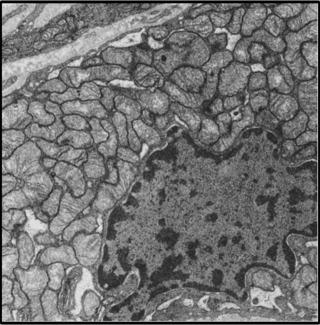
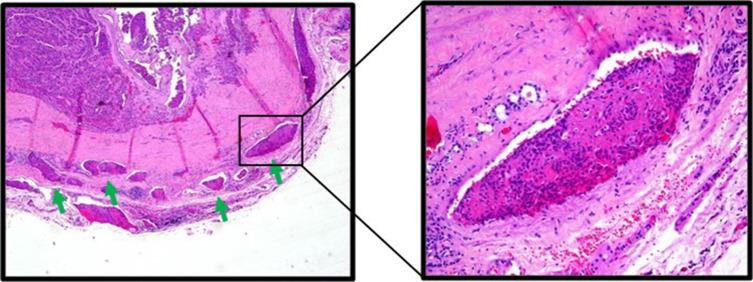
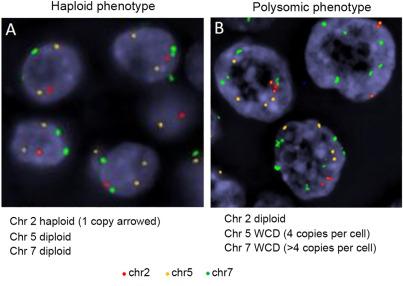
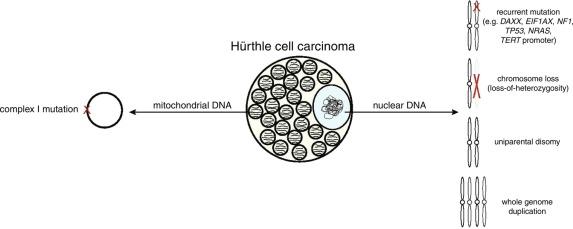
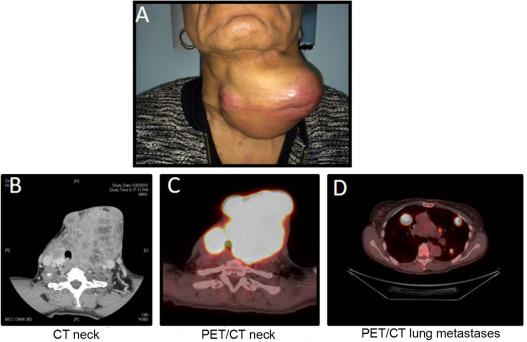
Most patients with HCC present with a thyroid nodule or mass. The mean age of presentation is between 50 and 60 years of age, approximately 10 years older than the mean age associated with other types of differentiated thyroid cancers. Several studies have reported a 3:1 preponderance in females.
Many have traditionally believed that HCCs behave in a more aggressive fashion than other well-differentiated thyroid cancers. However, the reported mortality and survival rates for HCCs are highly variable. Such controversy may be caused by the aforementioned pathologic diagnostic factors as well as small sample sizes, selection biases, and institutional treatment biases. Many earlier studies have reported higher mortality for HCC than for both papillary and follicular thyroid carcinoma, leading many to believe that HCCs are generally aggressive tumors with a worse prognosis than other well-differentiated thyroid cancers. In a study of 33 patients treated over 25 years at the University of California at San Francisco, Kushchayeva et al. reported a disease-specific survival (DSS) of 74% and 49% at 5 and 10 years, respectively, and a disease-free survival (DFS) of 65% and 40% at 5 and 10 years. The authors also reported a metastatic rate of 36% with a recurrence rate of 24% in these patients. Lopez-Penabad et al. reported a similarly high mortality rate of 40% associated with HCC in their cohort of 89 patients managed at the MD Anderson Cancer Center over a period of 50 years. These outcomes are in contrast with the 2% overall mortality rate for well-differentiated cancer. Other studies highlight a propensity to regional and distant metastatic behavior of HCCs. In a review of 59 patients with HCC treated over 60 years, Stojadinovic et al. reported a 33% rate of distant metastases and a 21% rate of nodal metastasis. Ruegemer et al. also demonstrated a 34% rate in distant metastases in HCCs compared with only a 7% and 19% rate in papillary thyroid cancer (PTC) and follicular thyroid cancer (FTC), respectively.
However, more recent studies and larger public database surveys have suggested better survival figures for HCCs, comparable to that of other differentiated thyroid cancer types. A review of 45 HCCs demonstrated a favorable overall outcome (DSS, 96% at 5 years) despite a high incidence of regional cervical metastases (55%). The high incidence of lymphatic spread and the relatively benign clinical course observed in this study is more in keeping with the clinical behavior of well-differentiated PTCs. Bhattacharyya examined the Surveillance, Epidemiology and End Results database (SEER) for the 10-year period between 1988 and 1998 for HCC and identified 555 cases of nonmetastatic HCCs. He reported an overall mean 5-year and 10-year survival rate of 85% and 71%, respectively. Mean survival figures for 411 matched FTCs were comparable. The author reported age and tumor size as the only variables to be predictors of a poorer outcome on multivariate analysis.
Until recently, the genetics of HCTs has been studied using a piecemeal approach and hence has remained poorly understood. Early gene expression analysis suggested that HCTs were derived from the follicular epithelium with some resemblance to FTCs. Their full transcriptional profile, however, hinted that they were molecularly distinct from other differentiated thyroid cancers. Indeed, targeted analysis of genes often altered in papillary and FTCs, such as BRAF and RAS , showed these genes to be infrequently mutated. Hotspot TERT promoter mutations were relatively more common but still only detected in a portion of HCC. Furthermore, gene rearrangements, such as the PAX8 / PPARγ and RET / PTC fusions, were also detected subsets of Hürthle tumors. These findings reinforced that HCC harbored a unique molecular foundation, a notion supported by the presence of noncanonical molecular changes in these tumors, including prominent chromosomal losses and mitochondrial DNA (mtDNA) mutations.
A more comprehensive understanding of the genetics of HCC has recently emerged from two whole-exome sequencing studies. These studies found recurrent nuclear DNA mutations in a diverse set of genes that included DAXX , EIF1AX , NRAS , KRAS , TP53 , CDKN1A , NF1 , ATM , and PTEN. Furthermore, hotspot TERT promoter mutations occurred in ~ 25% of cases and several novel gene fusions were identified. This heterogeneous catalog of candidate driver events highlights the importance of altered MAPK, PI3K, and DNA damage signaling as well as telomere maintenance in HCC.
The most prevalent alteration found in the nuclear DNA of HCC was widespread chromosomal losses, resulting in loss of heterozygosity (LOH) that, in some cases, spanned the majority of the nuclear genome. These striking LOH events resulted in “near-haploid” DNA content that in some cases was accompanied by duplication of the remaining chromosome, resulting in uniparental disomy (i.e., two copies of a chromosome coming from a single parent) or even whole genome duplication. Despite such pervasive LOH events, chromosomes 5, 7, and 12 were rarely lost and instead showed frequent duplication suggesting that important genes were resident on these chromosomes. Although the reason for this marked genomic instability is not yet known, the frequent LOH events appear to contribute to tumor suppressor inactivation.
A concurrent analysis of the mtDNA of HCC identified a number of somatic mtDNA mutations. The mtDNA is a small, circular genome with maternal inheritance that is distinct from the nuclear genome and present in multiple copies within each cell. The mtDNA codes for 13 proteins, all of which participate in mitochondrial oxidative phosphorylation (OXPHOS). The mitochondrial genome of HCC was unique in that disruptive mtDNA mutations were frequently observed, which stands in contrast to most other cancers where detrimental mtDNA mutations were not seen. Remarkably, these inactivating mutations nearly always occurred in genes encoding subunits of complex I, the nicotinamide adenine dinucleotide (NADH) dehydrogenase catalyzing the first step in mitochondrial OXPHOS. Although it is not clear how these mtDNA mutations contribute to tumor formation, their high prevalence in HCC suggests that loss of mitochondrial complex I, arguably a version of altered tumor metabolism, is a key genetic feature of this tumor.
Several prognostic scoring (age, gender, extent, and size [AGES]; age, metastasis, extent, and size [AMES]; and metastasis, age, completeness of resection, invasion, and size [MACIS]) and staging systems (Tumor, Node, Metastases; TNM) are used to evaluate well-differentiated thyroid cancers (see Chapter 24 , Dynamic Risk Group Analysis and Staging for Differentiated Thyroid Cancer). There is no specific staging system used for HCTs. The validity of the existing prognostic scoring systems has not been extensively evaluated for HCCs. One retrospective study of 40 HCC patients using the AMES risk scoring system showed its utility in predicting recurrence and survival as it found that all 19 low-risk patients remained disease free, whereas 48% of the 21 high-risk patients developed recurrence or died. Furthermore, both recent whole-exome sequencing studies of HCC found a provocative association between LOH and patient prognosis. First, the presence of LOH, or widespread chromosomal losses, was found to be the most frequently encountered event in metastatic HCC. Second, both studies found that the presence of LOH significantly correlated with worse patient outcomes, including progression-free and metastasis-free survival. In the future, as the ability to risk stratify thyroid tumors using their molecular features is further refined, this unique DNA copy number change in HCC may help identify tumors with a tendency for more aggressive behavior.
The presence of lymph node metastases associated with HCC at diagnosis, unlike papillary thyroid cancer (PTC), has been consistently shown in many studies to be associated with increased mortality and poorer outcome. A review of HCC patients treated between 1946 and 2003 by Mills et al. found that independent predictors of DFS were lymph node status, presence of distant metastases, and tumor stage.
As seen with other thyroid and nonthyroid cancers, the presence of distant metastases in HCC patients has been shown in numerous studies to be strongly associated with significantly poorer outcomes.
Become a Clinical Tree membership for Full access and enjoy Unlimited articles
If you are a member. Log in here